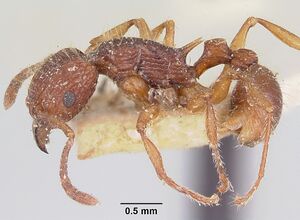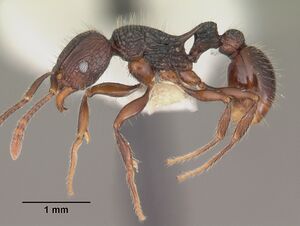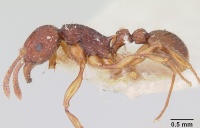Tetramorium andrei
| Tetramorium andrei | |
|---|---|

| |
| Scientific classification | |
| Kingdom: | Animalia |
| Phylum: | Arthropoda |
| Class: | Insecta |
| Order: | Hymenoptera |
| Family: | Formicidae |
| Subfamily: | Myrmicinae |
| Tribe: | Crematogastrini |
| Genus: | Tetramorium |
| Species: | T. andrei |
| Binomial name | |
| Tetramorium andrei Forel, 1892 | |
| Synonyms | |
| |
Tetramorium andrei is a widespread and common species found in most of the rainforests and montane rainforests of eastern and northern Madagascar. The southernmost locality is Andohahela in the southeast, and from there it ranges in an almost continuous band north to Montagne Francais in the northern tip of Madagascar. Fairly isolated from the main distribution, T. andrei is also encountered in Ambohijanahary and further north in Manongarivo and Ampasindava. The species was sampled at elevations from 10 to 1625 m, and lives in leaf litter. (Hita Garcia and Fisher 2012)
Identification
A member of the Tetramorium andrei species complex of the Tetramorium tortuosum-species group.
Hita Garcia and Fisher (2012) - Within the T. andrei species complex Tetramorium andrei is clearly identifiable based on the following character combination: eyes short to moderately sized (OI 19 - 25); propodeal spines long to very long (PSLI 32 - 45, usually below 40); in profile petiolar node with well-developed anterodorsal and posterodorsal angles, usually sharply defined, often one or both angles weakly rounded; posterodorsal corner of petiole not strongly protruding posteriorly; node in dorsal view ranging from as long as wide to 1.2 times longer than wide (DPeI 82 - 98); postpetiole in dorsal view as wide as long to approximately 1.4 times wider than long (DPpI 103 - 136); body colour ranging from uniform reddish-brown to very dark brown.
Within the species complex, T. andrei is not characterised and distinguishable by specialised characters, but instead by their lack. Tetramorium andrei (OI 19 - 25, usually above 20) differs strikingly from the two species with very small eyes: Tetramorium isectum (OI 15 - 16) and Tetramorium nify (OI 16 - 17). Furthermore, T. andrei can be easily distinguished from Tetramorium electrum, Tetramorium elf, and Tetramorium isoelectrum based on their smaller eyes (16 - 19), very long to extremely long propodeal spines (PSLI 46 - 64), and different body colours. Tetramorium electrum and T. isoelectrum are very dark brown to black and T. elf is of whitish to yellowish colour, and even though T. andrei shows a wide variation in colour, it is almost never yellowish as T. elf or as darkly coloured as T. electrum and T. isoelectrum. In addition, Tetramorium andohahela with its very distinctive petiolar node with the posterodorsal corner strongly protruding posteriorly cannot be misidentified with T. andrei, which does not have a node shape like that. Tetramorium ala, however, can be confused with T. andrei. They are both morphologically fairly similar, and in profile view almost indistinguishable. Nevertheless, in dorsal view they can be clearly separated from each other since the petiolar node of T. ala is much longer and thinner (DPeI 72 - 76) than that of T. andrei (DPeI 82 - 98). The last species of the complex, Tetramorium voasary, is morphologically also comparatively close to T. andrei. Their separation is based on the shape differences of both waist segments. In T. andrei the petiolar node in lateral view usually has very well defined, almost sharp, anterodorsal and posterodorsal margins, although they are often moderately rounded, and the postpetiole in dorsal view is between 1.0 to 1.4 times wider than long (DPpI 103 - 136). In contrast, the petiolar node of T. voasary has anterodorsal and posterodorsal margins that are fairly rounded, and a relatively longer postpetiole which is slightly longer than wide to slightly wider than long (DPpI 95 - 101).
Keys including this Species
Distribution
Latitudinal Distribution Pattern
Latitudinal Range: 25.0877° to -24.73333333°.
| North Temperate |
North Subtropical |
Tropical | South Subtropical |
South Temperate |
- Source: AntMaps
Distribution based on Regional Taxon Lists
Malagasy Region: Madagascar (type locality).
Distribution based on AntMaps
Distribution based on AntWeb specimens
Check data from AntWeb
Countries Occupied
| Number of countries occupied by this species based on AntWiki Regional Taxon Lists. In general, fewer countries occupied indicates a narrower range, while more countries indicates a more widespread species. |

|
Estimated Abundance
| Relative abundance based on number of AntMaps records per species (this species within the purple bar). Fewer records (to the left) indicates a less abundant/encountered species while more records (to the right) indicates more abundant/encountered species. |

|
Biology
Castes
Worker
Images from AntWeb
   
| |
| Paralectotype of Tetramorium andrei. Worker. Specimen code casent0101282. Photographer April Nobile, uploaded by California Academy of Sciences. | Owned by MHNG, Geneva, Switzerland. |
   
| |
| Lectotype of Tetramorium andrei. Worker. Specimen code casent0101821. Photographer April Nobile, uploaded by California Academy of Sciences. | Owned by MHNG, Geneva, Switzerland. |
   
| |
| Worker. Specimen code casent0102395. Photographer April Nobile, uploaded by California Academy of Sciences. | Owned by NHMUK, London, UK. |
   
| |
| Syntype of Tetramorium robustior. Worker. Specimen code casent0101279. Photographer April Nobile, uploaded by California Academy of Sciences. | Owned by MHNG, Geneva, Switzerland. |
   
| |
| Syntype of Tetramorium robustior. Worker. Specimen code casent0101280. Photographer April Nobile, uploaded by California Academy of Sciences. | Owned by MHNG, Geneva, Switzerland. |
   
| |
| Worker. Specimen code casent0102983. Photographer April Nobile, uploaded by California Academy of Sciences. | Owned by NHMUK, London, UK. |
Nomenclature
The following information is derived from Barry Bolton's Online Catalogue of the Ants of the World.
- andrei. Tetramorium (Xiphomyrmex) andrei Forel, 1892l: 263 (w.) MADAGASCAR. Combination in Xiphomyrmex: Wheeler, W.M. 1922a: 1031; in Tetramorium: Bolton, 1979: 143. Senior synonym of robustior: Hita Garcia & Fisher, 2012: 26.
- robustior. Tetramorium (Xiphomyrmex) andrei r. robustior Forel, 1892k: 521 (w.) MADAGASCAR. Raised to species: Bolton, 1979: 147. Junior synonym of andrei: Hita Garcia & Fisher, 2012: 26.
Unless otherwise noted the text for the remainder of this section is reported from the publication that includes the original description.
Hita Garcia and Fisher (2012) - It must be pointed out that T. andrei displays an extraordinary level of intraspecific variation, and we are confident that the material included under this name consists of three to four "good" species that we are unfortunately unable to delimit in this study. The morphometric range outlined above, based on 65 measured specimens, shows a remarkable variability not found in another Afrotropical or Malagasy Tetramorium. There are a number of characters that are variably developed, often within the same locality, which do not allow a consistent species delimitation. The most important characters are head shape (CI 91 - 100), antennal scape length (SI 68 - 86), the development of the propodeal lobes and the petiolar node, and the sculpture on the mandibles. There seem to be three to four relatively discrete groups that can be recognised by morphometrics and few important characters.
The first group is found in the southeast from Andohahela north to Andringitra, and is mainly characterised by relatively short antennal scapes (SI 68 - 74), short, rounded propodeal lobes, and a petiolar node without very sharply defined antero- and posterodorsal margins. The second group, which contains the type material of T. andrei, has significantly longer antennal scapes (SI 80 - 86), short but acute propodeal lobes, and a petiolar node with very well-developed and sharply defined antero- and posterodorsal margins. This group is mainly found in central-eastern Madagascar from Vevembe and Vatovavy north to Mandrisy. The third group contains the types of the junior synonym T. robustior, and is found from central-eastern to north-eastern Madagascar. It is characterised by comparatively longer antennal scapes (SI 80 - 85), longer, elongate-triangular, and very acute propodeal lobes, and a petiolar node with the posterodorsal margin weakly higher and more angular than the anterodorsal margin. The head in this group shows the widest shape with a CI approaching 100. The last group seems restricted to northern parts of Madagascar and is encountered north of Manongarivo in the West and Marotandrano in the east. In this group the mandibles are often unsculptured or almost unsculptured, and generally very smooth and shining. Also, the antennal scapes are relatively short (SI 70 - 77), the propodeal lobes are short, triangular, and often blunted, and the petiolar node has less strongly marginate antero- and posterodorsal margins. Sometimes, especially in Manongarivo, the anterodorsal margin of the petiole is situated slightly higher, although this is not consistent in that series.
Despite encountering these four groups within the extensive material of T. andrei examined during this study, we are reluctant to describe these as different species at the moment, even though some or all likely deserve species status. We observed that several of the characters mentioned above show a gradual overlap from one group to another, and it was not possible to draw significant lines between these groups recognisable for non-taxonomists to describe them as distinct species. Therefore, even though we examined several hundred specimens, we postpone a solution to this species delimitation problem within T. andrei. We are still confident that there are several more or less cryptic species involved, and for future studies we recommend measuring significantly more specimens than the 65 measured here. Morphometrics appears to be of high importance to find species limits, and might be a useful means to solve this problem. Molecular data, if possible from multiple genes, may also be necessary to support morphological and morphometric diagnostics.
Description
Worker
Hita Garcia and Fisher (2012) - HL 0.77 - 1.11 (0.95); HW 0.73 - 1.06 (0.91); SL 0.60 - 0.86 (0.70); EL 0.15 - 0.23 (0.20); PH 0.37 - 0.55 (0.47); PW 0.53 - 0.75 (0.67); WL 0.96 - 1.40 (1.20); PSL 0.27 - 0.46 (0.36); PTL 0.27 - 0.36 (0.32); PTH 0.29 - 0.45 (0.37); PTW 0.23 - 0.33 (0.28); PPL 0.26 - 0.37 (0.32); PPH 0.29 - 0.45 (0.37); PPW 0.30 - 0.44 (0.37); CI 91 - 100 (96); SI 68 - 86 (77); OI 19 - 25 (22); DMI 50 - 60 (56); LMI 37 - 43 (39); PSLI 32 - 45 (38); PeNI 36 - 48 (42); LPeI 76 - 97 (86); DPeI 82 - 98 (90); PpNI 48 - 63 (55); LPpI 75 - 98 (88); DPpI 103 - 136 (116); PPI 117 - 149 (131) (65 measured).
Head distinctly longer than wide to as long as wide (CI 91 - 100). Posterior head margin weakly concave. Anterior clypeal margin medially impressed. Frontal carinae strongly developed, diverging posteriorly, and ending at corners of posterior head margin. Antennal scrobes weakly developed, shallow, narrow, and without defined posterior and ventral margins. Antennal scapes comparatively short to moderately long, not reaching posterior head margin (SI 68 - 86). Eyes short to moderately sized (OI 19 - 25). Mesosomal outline in profile flat to weakly convex, moderately marginate from lateral to dorsal mesosoma; promesonotal suture and metanotal groove absent; mesosoma comparatively stout and high (LMI 37 - 43). Propodeal spines long, rarely very long, spinose, and acute (PSLI 32 - 45, usually below 40); propodeal lobes variable, short and weakly developed to well-developed and moderately long, triangular to elongate-triangular, and rounded and blunt to acute. Petiolar node in profile rectangular nodiform with usually well-defined angles, node ranging from as high as long to 1.3 times higher than long (LPeI 76 - 97), anterior and posterior faces approximately parallel, anterodorsal and posterodorsal margins approximately at same height, dorsum straight to weakly convex, sometimes anterodorsal or posterodorsal margins slightly higher than other; node in dorsal view ranging from as long as wide to 1.2 times longer than wide (DPeI 82 - 98). Postpetiole in profile globular to subglobular, approximately as high as long to 1.3 times higher than long (LPpI 75 - 98); in dorsal view between as wide as long to approximately 1.4 wider than long (DPpI 103 - 136). Generally, postpetiole in profile approximately as voluminous as petiolar node, in dorsal view postpetiole approximately 1.2 to 1.5 times wider than petiolar node (PPI 117 - 149). Mandibles usually distinctly longitudinally rugose, in some localities mandibles weakly sculptured to completely unsculptured, smooth, and shining; clypeus usually longitudinally rugose/rugulose, almost always with one distinct median ruga/rugula, often two well-developed rugae/rugulae laterally, sometimes only median ruga/rugula distinct and remaining sculpture irregularly arranged; cephalic dorsum between frontal carinae with 7 to 12 longitudinal rugae running from posterior head margin to posterior clypeus, rugae often broken, rarely with cross-meshes; lateral and ventral head mainly reticulate-rugose and to lesser extent longitudinally rugose. Mesosoma laterally and dorsally distinctly longitudinally rugose. Forecoxae usually completely unsculptured, smooth, and shiny, sometimes with partial superficial sculpture. Waist segments longitudinally to irregularly rugose. Generally ground sculpture faint to absent everywhere on body, rarely head with weak to moderate reticulate-punctate ground sculpture. First gastral tergite unsculptured, smooth, and shining. All dorsal surfaces of head, mesosoma, waist segments, and gaster with abundant, long, and fine standing hairs. Anterior edges of antennal scapes with subdecumbent to erect standing hairs. Body colour ranging from uniform reddish-brown (most commonly encountered) to very dark brown, often appendages of much lighter colour.
Type Material
Hita Garcia and Fisher (2012):
Lectotype worker [designated here], MADAGASCAR, Toamasina, province de Bezanozano, Nosibé Village de I’Imerina (M. Sikora) (Musee d'Histoire Naturelle Genève: CASENT0101821) [examined]. Paralectotypes, two workers with same data as holotype (MHNG: CASENT0101281; CASENT0101282) [examined].
Tetramorium (Xyphomyrmex) andrei st. robustior Syntype workers, Foret d'Andrangoloaca (M. Sikora) (MHNG: CASENT0101279, CASENT0101280) [examined].
Note: there is a bit of confusion concerning the type locality of T. andrei. The type locality information on the labels from MHNG is clearly "Nosibé Village del I’Imerina (Sikora)", whereas the description by Forel gives the type locality as "Environs de la ville d'Anosibé (province de Bezanozano), a trois journées a l'est-sud-est d'Antananarivo (M. Sikora)." There are several places with the names Nosibé or Anosibé in Madagascar, and additional information is necessary to ascertain which was meant by Forel. Since he mentioned that the locality was three days’ march ESE of Antananarivo in the province of Bezanozano we can hypothesize that it might be close to present-day Anosibe an 'Ala in Toamasina, which is ESE of Antananarivo approximately 30 km south of Moramanga and in the traditional area of the Bezanozano people. Some uncertainty remains, but we think that this locality data is the closest to Forel's (1891) description.
References
- Bolton, B. 1979. The ant tribe Tetramoriini (Hymenoptera: Formicidae). The genus Tetramorium Mayr in the Malagasy region and in the New World. Bull. Br. Mus. (Nat. Hist.) Entomol. 38: 129-181 (page 143, Combination in Tetramorium)
- Cantone S. 2018. Winged Ants, The queen. Dichotomous key to genera of winged female ants in the World. The Wings of Ants: morphological and systematic relationships (self-published).
- Forel, A. 1892o. Les Formicides. [concl.]. In: Grandidier, A. Histoire physique, naturelle, et politique de Madagascar. Volume XX. Histoire naturelle des Hyménoptères. Deuxième partie. Supplèment au 28e fascicule. Paris: Hachette et Cie, pp. 229-280. (page 263, worker described)
- Hita Garcia, F. and B. L. Fisher. 2012. The ant genus Tetramorium Mayr (Hymenoptera: Formicidae) in the Malagasy region - taxonomic revision of the T. kelleri and T. tortuosum species groups. Zootaxa. 3592:1-85. PDF
- Wheeler, W. M. 1922k. Ants of the American Museum Congo expedition. A contribution to the myrmecology of Africa. IX. A synonymic list of the ants of the Malagasy region. Bull. Am. Mus. Nat. Hist. 4 45: 1005-1055 (page 1031, Combination in Xiphomyrmex)
References based on Global Ant Biodiversity Informatics
- Bolton B. 1979. The ant tribe Tetramoriini (Hymenoptera: Formicidae). The genus Tetramorium Mayr in the Malagasy region and in the New World. Bulletin of the British Museum (Natural History). Entomology 38:129-181.
- Fisher B. L. 1996. Ant diversity patterns along an elevational gradient in the Réserve Naturelle Intégrale d'Andringitra, Madagascar. Fieldiana Zoology (n.s.)85: 93-108
- Fisher B. L. 1997. Biogeography and ecology of the ant fauna of Madagascar (Hymenoptera: Formicidae). Journal of Natural History 31: 269-302.
- Fisher B. L. 1998. Ant diversity patterns along an elevational gradient in the Réserve Spéciale d'Anjanaharibe-Sud and on the western Masoala Peninsula, Madagascar. Fieldiana Zoology (n.s.)90: 39-67.
- Fisher B. L. 2003. Formicidae, ants. Pp. 811-819 in: Goodman, S. M.; Benstead, J. P. (eds.) 2003. The natural history of Madagascar. Chicago: University of Chicago Press, xxi + 1709 pp.
- Forel A. 1892. Nouvelles espèces de Formicides de Madagascar (récoltées par M. Sikora). Première série. Annales de la Société Entomologique de Belgique. 36: 516-535.
- Hita Garcia F., and B. L. Fisher. 2012. The ant genus Tetramorium Mayr (Hymenoptera: Formicidae) in the Malagasy regiontaxonomic revision of the T. kelleri and T. tortuosum species groups. Zootaxa 3592: 1-85.
- Rakotonirina J. C. 2010. Survey of leaf litter ant species and assessment of invasive ants in the mining sites at Ambatovy, Madagascar. In Biodiversity, exploration, and conservation of the natural habitats associated with the Ambatovy project, eds. S. M. Goodman & V. Mass. Malagasy Nature, 3: 77-91.
- Santschi F. 1928. Descriptions de nouvelles fourmis éthiopiennes (suite). Revue de Zoologie et de Botanique Africaines. 16: 191-213.
- Wheeler W. M. 1922. Ants of the American Museum Congo expedition. A contribution to the myrmecology of Africa. IX. A synonymic list of the ants of the Malagasy region. Bulletin of the American Museum of Natural History 45: 1005-1055

